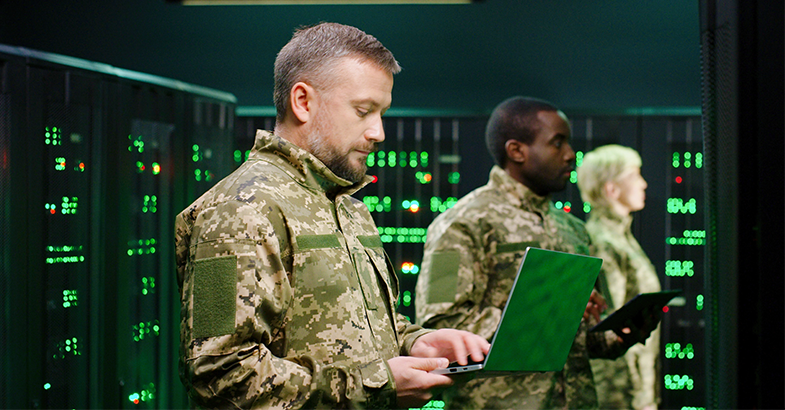
According to Allied Market Research, the market for global autonomous weapons is expected to increase from $12 billion this year to a whopping $30 billion by the end of the decade. https://www.alliedmarketresearch.com/autonomous-weapons-market-A13132
Time and again, technology has changed the face of combat. It has catalyzed innovation in military warfare.
Missile Defence systems such as the Patriot and the Phalanx that operate autonomously to attack enemy aircraft/ surface vessels and sentry guns deployed on armoured vehicles have been used in defensive military actions. So, what is different now?
The technology is far more sophisticated and accurate. Military Systems worldwide are trying to plug-in Metallic intelligence with traditional combat operations. Artificial Intelligence is motivating nations to adopt advanced technologies to display their dominance in global power play. AI-backed Military systems can help design & deploy more efficient & effective battle plans both in information-dense and information-sparse situations. AI tools can make data-based decisions in record time from unstructured data available and offer real-time decisions to context-based challenges in war zones. This transition to digitized warfare has and will bring about a paradigm shift in the way wars are fought from destruction-based to knowledge-based.
Nations are turbo-charging warfare capabilities by doubling down on AI-powered autonomous systems. Few examples:
LAWS (Lethal Autonomous Weapon Systems) use sensors and AI to select and destroy targets.
AI-enabled drones that can carry radar, jamming devices, guns, or even bombs for attack without collateral damage.
AI-powered robots- coupled with computer vision and IoTs, that carry out attacks without human intervention.
AI-based Autonomous Detection Systems (such as DRDO’s Daksh) electrically powered- remotely operated vehicles (ROV) used for landmine detection. Minect.ai is an AI-based landmine Detection that uses neural networks and visual data streams from drones, robots, and smartphones in real-time to exact the location of landmines.
Integrated Speech Solutions leverages Automatic Speech Recognition (ASR), Machine Learning, and Voice-to-text to translate various languages.
https://analyticsindiamag.com/5-ai-tools-for-modern-warfare/
“Artificial intelligence is the future, not only of Russia, but of all mankind. Whoever becomes the leader in this sphere will become ruler of the world.” ~ Vladimir Putin, 2017
The ongoing war between Russia and Ukraine is a testing ground for many Artificial Intelligence (AI) based technologies to analyze battlefield data, including surveillance footage from drones.
Reports suggest Russia’s use of ‘KUB-LA, ‘ known as ‘Kamikaze Drone’ manufactured by Zala-Aero in its operations against Ukraine. This ‘loitering munition’ can autonomously fly to a specific area and circle it for about 30 minutes. If equipped with AI software, it can hunt for targets whose images have been fed to the onboard system, nosedive into its quarry, and explode.
Ukraine has been using the Turkish-made Bayraktar TB2 drones and is said to have received 100 Switchblades from the US. It has deployed facial recognition software from Clearview AI to identify Russian soldiers killed in combat. Clearview AI has offered free access to Ukrainian officials to its service that matches images uploaded on the internet to identify someone. This has the potential for Ukraine to upend Russia’s War Information filter and bring closure to the deceased soldier’s family.
AI could also play a vital role in the information and misinformation war. Deepfakes are the persuasive-looking but false video and audio files made with the help of artificial intelligence. They can supercharge disinformation campaigns. Now, they’re being used to impact the course of a war. The past couple of weeks have seen Deepfake videos of Ukrainian President Zelensky and Russian President Vladimir Putin supposedly declaring peace in the Ukraine war.
On the other hand, Machine Learning can be used to help detect disinformation too. AI can help analyze the vast amount of open-source intelligence coming out of the battlefield – everything from TikTok videos, tweets, and FB. This could allow civil society groups to fact-check the claims made by both sides in the conflict and document potential atrocities and human rights violations. That could be vital for future war crimes prosecutions.
https://fortune.com/2022/03/01/russia-ukraine-invasion-war-a-i-artificial-intelligence/
As technology improves at a giddy pace, costs of making semiautonomous and autonomous drones continue to be a fraction of the price of Predator drones, which cost tens of millions of dollars. While use of autonomous drones would inflict targeted damage, it has the potential to minimize the loss of thousands of soldier lives. However, Human rights Activists and some computer scientists fear a grave threat to civilians in combat zones.
The future of AI in war is already here. The USA, China, Russia, Britain, Israel, and Turkey are all aggressively designing AI-enabled weapons that can shoot to kill with no humans in the decision-making loop. These are autonomous weapons with enhanced intelligence for more complex decisions for offensive attacks. Weapons that engage fully- from looking for targets, deciding to engage, attacking the target – all without human intervention in decision-making. These include fleets of ghost ships, land-based tanks and vehicles, AI-enabled guided missiles, and, most prominently, aircrafts.
AI coupled with increased processing power is expected to be applied to military planning, operations, command, and decision support as part of the “intelligentization” of warfare. It is possible that using AI to predict where and when conflicts will escalate into war could help peacekeepers and aid agencies intervene before they turn into a humanitarian disaster. AI could help assess global data on past conflicts, model approaches to simulating ceasefires and map peace agreements. It could also run ‘Sentiment Analysis’ on social media of supporters on both sides to better understand the conflict, generate more comprehensive public opinion, build pressure for peacekeeping, and avoid full-fledged aggression.
There is growing interest in the potential for AI to play a role in advising on or resolving complex conflicts. In the future, AI-based approaches could replace humans in resolving international disputes and military conflicts.
https://www.brinknews.com/could-artificial-intelligence-prevent-future-wars/

